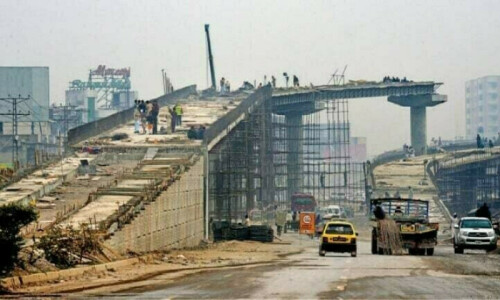
PAKISTAN’S transition from water-rich to water-stressed didn’t come without fair warning. At the turn of the ’90s, experts predicted that freshwater resources in the country would dwindle substantially and become scarce by 2005. The predicted ‘waterfall’ was confirmed by the Pakistan Council of Research in Water Resources (PCRWR), which further added that acute water shortage would follow by 2025 if the current situation was allowed to prevail.
While our country is no stranger to various kinds of shortfalls, the impending water crisis is not one that will stay confined to the odd street demonstration; unlike, for example, in the case of electricity shortage, where protests can be curbed by simply reallocating electricity from rural suburbs to urban metropolises. When the most essential compound on earth absolutely necessary to sustain life and land is threatened, it could potentially signal the onset of armed conflict in an already volatile region.
The deadly drought that plagued Syria from 2007 to 2010 gives further context to that statement. Ancient irrigation technologies combined with water mismanagement have contributed significantly to the ongoing conflict in Syria, which has claimed thousands of lives and incurred millions in property damage. Widespread crop failures led to mass migration of families that relied solely on farming as their primary source of income.
The large-scale exodus of ‘water refugees’ to neighbouring Jordan and Sudan is stretching thin the host countries’ water resources as well. The influx of 600,000 refugees into Jordan, for instance, has caused ground water resources there to fall into sharp decline. Consequently, interpersonal dynamics between the natives and refugees are worsening steadily. Needless to say, in a region that faces conflict on several fronts, scarcity of water can drastically increase the likelihood of local skirmishes breaking out over control of the remaining resources.
Severe water shortages could presage armed conflict.
Although there are no parallels between war-torn Syria and terrorism in Pakistan, the water situation, on the other hand, is following the same predicted trajectory. Our water reserves are erratically disseminated at best. Punjab gets 55.94 million acre feet — the lion’s share of the overall water supply. Other provinces, Sindh in particular, accuse Punjab of leveraging its upstream position and controlling the water infrastructure to determine sharing on the basis of historic use.
The disproportionate distribution is cause for considerable tensions between the provinces. Attempts to initiate the construction of new dam projects to preserve water, as well as increase power output, have met an early demise in the past because a single, cohesive solution that benefited all stakeholders equally could not be mutually agreed upon.
Apart from interprovincial water disputes, experts often cite global warming as a phenomenon that is causing rapid depletion of our water resources. For a country heavily dependent on the annual monsoon rains and summer ice melt in the Himalayas to replenish its aquatic reserves, the effects of climate change are undeniable. However, that argument only takes into account one side of an extremely intricate water equation. Man-made interventions — or lack thereof — are as much to blame as Mother Nature retaliating to even the odds.
Take into account the crucial agriculture sector of our country. Being the primary driver of Pakistan’s economy, agriculture accounts for 20pc of Pakistan’s overall GDP and it is the livelihood of half its inhabitants. The Indus and its associated rivers and tributaries form the lifeline of the agrarian industry, which relies on the single largest contiguous irrigation system in the world. Despite that impressive feat, Pakistan’s crop yield per unit is among the lowest in the world — an alarming state of affairs considering that an astonishing 97pc of our water supply is made available to the agricultural sector alone.
However, due to reliance on obsolete irrigation practices and subpar delivery systems, two-thirds of surface water is lost to seepage and evaporation — water that could be harnessed to irrigate arid lands and exponentially increase crop yields. As a result, 29pc of the overall perfectly cultivatable land (or 22.6 million acres) remains uncultivated, which in turn affects national food security.
While the loss of water is causing the agricultural sector to spiral downwards, it has severe implications for the national economy as well. Once crops are lost due to drought, rifts begin to develop among the populace. The resulting social unrest is likely to aggravate the security situation if the country is already struggling to maintain peace. Add the interprovincial water dispute to the mix and the equation becomes increasingly hostile.
The current status quo is a result of political inaction and lack of funding for PCRWR to conduct water preservation studies. Unfortunately, if the threat of acute water shortage is prolonged any further it would grow to rival and surpass homegrown militancy in its potential to cause harm.
The writer is a researcher.
Twitter: @fahadamalik
Published in Dawn November 10th, 2016










































